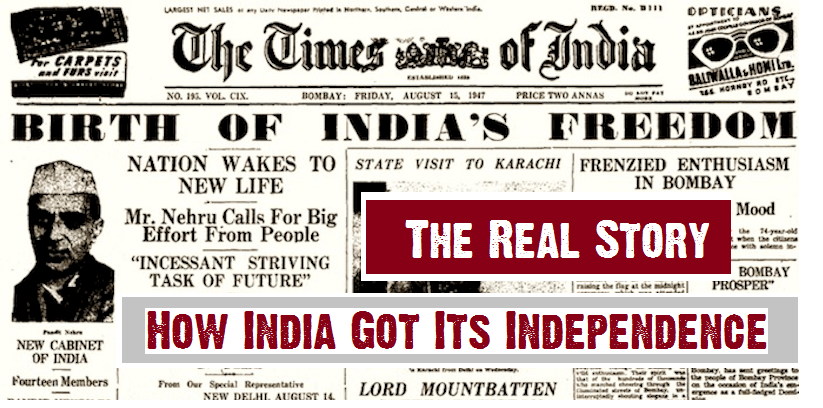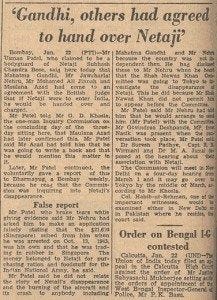How India got its Independence – The Real Story

Utpal Dutt, the actor who played comedian in one of most memorable role in Hindi Cinema in Golmaal, was arrested on December 27, 1965 by the Government of West Bengal under the Preventive Detention Act. The Government of Bengal and India feared he was “subversive”. Why? Because he wrote a play called “Kallol” (Sound of Waves) on an important chapter of Indian Freedom that is never mentioned in any official History book. The Royal Indian Navy Mutiny (or Naval Uprising) of 1946.
The Beginning
British were in trouble in 1946. Indians in the Armed forces were no longer trust worthy. The mutiny, that no one in our generation has ever heard of, did to the British colonization, what no other action could have done in the long struggle of 250 years.
Said Sir Stafford Cripps, intervening in the debate on the motion to grant Indian Indepence in the British House of Commons in 1947 (‘The Freedom Struggle and the Dravidian Movement’ by P.Ramamurti, Orient Longman, 1987)
…The Indian Army in India is not obeying the British officers. We have recruited our workers for the war; they have been demobilised after the war. They are required to repair the factories damaged by Hitler’s bombers. Moreover, they want to join their kith and kin after five and a half years of separation. Their kith and kin also want to join them. In these conditions if we have to rule India for a long time, we have to keep a permanent British army for a long time in a vast country of four hundred millions. We have no such army….”
In August 1945, Subhash Bose had reportedly died, while he collaborated with the Japanese and Hitler to fight the British. After the Second World War was over, three of the top officers of the Indian National Army (INA) – General Shah Nawaz Khan (Muslim), Colonel Prem Sehgal (Hindu) and Colonel Gurbaksh Singh Dhillon (Sikh) were put on trial at the Red Fort in Delhi. Their crime: “waging war against the King Emperor”
While Nehru was busy “defending” the three; he (Nehru), Gandhi, Mohd. Ali Jinnah, and Maulana Abul Kalam Azad had come to a secret pact that if Subhash Bose was to enter India (as many knew he hadn’t died in 1945), he would be handed over and charged.
Unprecedentedly, these trials were very public. Due to the sympathy toward Netaji and the INA in general, there was an instant and large outpouring of passion and patriotism in Indians. These stories were being shared via wireless sets and through media in general on the ships, where the sailors who were being given bad treatment (lack of proper service facilties), got inspired to go out and join together in a strike and rebel against the government.
The Spread
The mutiny started on 18 February 1946 and by next evening a Naval Central Strike Committee was formed where Leading Signalman M.S Khan and Petty Officer Telegraphist Madan Singh were unanimously elected President and Vice-President respectively.
The spread of the Naval mutiny, which started in Bombay was complete – Karachi, Calcutta, Cochin and Vizag. 78 ships, 20 shore establishments and 20,000 sailors had been involved in the strike.
Seeing this Naval strike, the Bombay-ites did a one day general strike. Even the Royal Indian Air Force and local police forces joined in the other cities. The NCOs in the British Indian army openly ignored and defied the orders of the British superiors. In Madras and Pune, the Indian Army revolted in the British Garrisons.
Riots broke out all over the country. The mutineers were hoisting 3 flags – Indian National COngress, Muslim League and CPI. British people in cars were made to get off and shout “Jai Hind” by the mutineers. The Indian Tricolor was hoisted on many ships and establishments, by just the second day.
Such was the crisis that destroyers were gotten and stationed at the Gateway of India in Bombay to deal with the mutineers. Navies of Australia and Canada were also summoned.
The third day into this – the Royal Air Force flew an entire squadron of Bombers over Bombay Harbor to show support. Meanwhile the sailors had taken over HMIS Bahadur, Chamak and Himalaya and from the Royal Naval Anti-Aircraft School .
It was by that time that the decision to confront the Navy ratings was taken by the British and the sailors aboard the destroyer Hindustan were challenged. The sailors lost many lives and could not fight back much and in the process the ship Hindustan was destroyed.
Betrayal by Gandhi, Nehru, Jinnah and Azad
Despite the extensive public support and support from all the wings of the Armed forces – Army, Navy, Air force, and even police – apart from unanimous coming together of people across religious groups at a time when the religious situation had been made really bad due to Partition debate and passion, ALL the National Leaders not only did NOT support the Navy Mutineers and their supporters but instead condemned them.
They were leaderless, surely, but they had achieved what NO OTHER generation and group of Indians had achieved in 250 years – turn the Indian Armed forces personnel against their Masters. Subhash Bose had imagined this kind of situation. Little did he know that from the failure of his own Army, would arise a rebellion and a will to fight amongst the rank and file of Indian soldiers hitherto fighting dutifully for the British, often against their own countrymen, to strike back.
The Mainstream politicians – from Jinnah to Gandhi, to Nehru to Maulana Azad – ALL let these final Freedom fighters down. They just abandoned them and except for preaching they did nothing to help them.
In midst of one of most unprecedented religious tension in the sub-continent, this rebellion and its genesis was a Godsend to reinforce religious and class harmony, which was forged instantly WITHOUT any machination. Yet, it was squandered…. probably deliberately by all those who promised us peace and harmony.
These people – the so-called Mainstream politicians spearheaded by Gandhi were interested in only their hold of their masses.. to see themselves being upstaged by a bunch of young upstarts with romantic patriotism in their eyes was unnerving. (James L. Raj; Making and unmaking of British India. Abacus. 1997. p598) Show of fake “constitutional process” and “principles” was a good way to brush them aside despite all they had been able to do.
Real Reason for Independence
So what were the three things which convinced the British that India could not be governed by force anymore?
Subhash Bose, Indian National Army and the Royal Navy Uprising..
When Justice P.B. Chakrabarty, the Chief Justice of Calcutta High Court once asked the British PM Lord Clement Atlee – responsible for conceding India’s Independence, the all important question –
“what was the extent of Gandhi’s influence upon the British decision to quit India”
His response, with a smirk: “m-i-n-i-m-a-l!“
So, then why did they have to leave if the Quit India movement of 1942 had subsided and nothing major happened in the mainstream politics – then why did the British have to leave so suddenly in 1947??
Clement Atlee’s response:
Erosion of loyalty to the British Crown among the Indian army and navy personnel as a result of the military activities of Netaji
Such was the Congress party scared of the truth coming out that as late as 1965, a Marxist theater actor and writer Utpal Dutt was arrested for writing a passionate play on the VERY event that ensured India its Independence – the Royal Navy Uprising!
But as the story goes in our History books…….
Reference Links:
1. Royal Indian Navy Mutiny
2. Subhas Chandra Bose, the Indian National Army, and the War of India’s Liberation – Ranjan Borra, Journal of Historical Review, no. 3, 4 (Winter 1982)
3. Inside the actor’s mind





